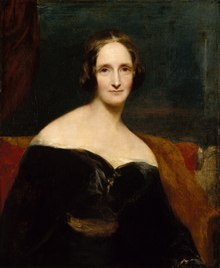Mary Shelley
![]()
The title of this article is ambiguous. For other meanings, see Mary Shelley (disambiguation).
Mary Shelley (born August 30, 1797 in London, England; † February 1, 1851 there), born Mary Godwin, often referred to as Mary Wollstonecraft Shelley, was an English writer of the early 19th century. She has gone down in literary history as the author of Frankenstein, or The Modern Prometheus (1818), one of the best-known works of Romantic and fantastic literature. Her complete works include several novels, short stories, plays, essays, poems, reviews, biographies, and travel narratives. She also edited the work of her husband, Percy Bysshe Shelley, who died at an early age. Her father was the social philosopher and founder of political anarchism William Godwin. Her mother was the writer and feminist Mary Wollstonecraft, who wrote one of the seminal works of the women's rights movement, Vindication of the Rights of Woman (1792).
Mary Godwin's mother died eleven days after the birth of her daughter. William Godwin raised his daughter himself, together with her older half-sister Fanny Imlay. They received an informal but thoroughly comprehensive education through him and his second wife Mary Jane Clairmont, in which William Godwin encouraged his daughters to follow his liberal political theories. In 1814 Mary Godwin fell in love with the married Percy Bysshe Shelley, an admirer of her mother's works and a supporter of her father's political ideas. Together with her stepsister Claire Clairmont, Mary Godwin, only sixteen years old, followed her friend Percy B. Shelley on a journey through Europe. Upon their return, Mary Godwin was pregnant. For the next two years, the unmarried couple faced social ostracism for their openly unconventional lifestyle.
The couple spent the summer of 1816 together with Lord Byron, John William Polidori and Claire Clairmont on Lake Geneva. It was there that Mary Godwin conceived her idea for her novel Frankenstein. Towards the end of 1816, a few weeks after the suicide of Percy Shelley's first wife Harriet, the couple married. In 1818, the two settled in Italy for an extended period of time. In 1822, Percy B. Shelley drowned while sailing in the Gulf of La Spezia. A year later, Mary Shelley returned to England with her last-born and only surviving child, where she successfully continued her career as a writer. The last decade of her life was marred by illness. She died at the age of 53, presumably of a brain tumor.
Until the 1970s, Mary Shelley was primarily perceived as the executor of her husband's estate and the author of the novel Frankenstein. Her best-known work is still read two hundred years after its first publication and has been adapted several times for stage and film. Since the 1970s, literary scholars have come to a more comprehensive appreciation of her varied oeuvre and now also acknowledge her later novels, such as the historical novel Valperga (1823), Perkin Warbeck (1830), the apocalyptic novel The Last Man (1826), and her last two stories Lodore (1835) and Falkner (1837). A closer examination of her lesser-known works, such as the travelogue Rambles in Germany and Italy (1844) and the biographical essays for Dionysius Lardner's Cabinet Cyclopaedia (1829-1846), reveals that Mary Shelley held radical political ideas until the end of her life. Her works often contain the view that social reform could be instigated by cooperative and understanding behaviour on the part of women. With this conviction she stood in contrast to the individualistic romanticism as represented by Percy Shelley and the political theories of her father, William Godwin.
Search within the encyclopedia

